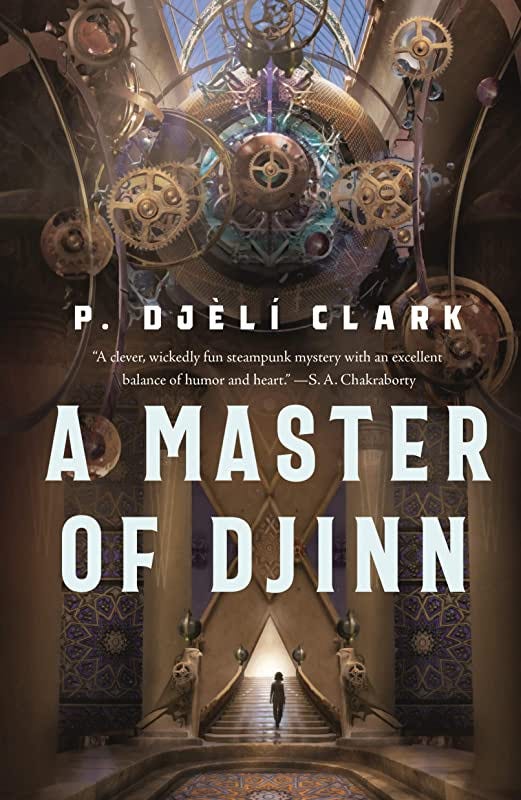Creating a Fantasy Metropolis
Tales from The Dripping Tap #0
“Cities begin in the mind”
-Elias Canetti
Like many ttrpg fans, I’ve got this fantasy world kicking around my head at all times. A campaign setting where I borrow from history, in the process of inventing a fictional world. For years through most of the pandemic I ran a game in a corner of my campaign setting that was a hexcrawl; it took place in a vaguely Iberian peninsula beset with a curse of undeath, vast stretches of woods between small points of light and the art of Russian artist Artem Demura always in my mind.
A great game, one of my favorites; but we did this for three years. I was in drastic need of a tonal change in the coming future, and after reading some Discworld novels, I had an idea: my own fantasy metropolis. My Ptolus, my Ankh-Morpork, my Camorr — a home for rogues, vagabonds and dodgy dealings. Players could get up to all sorts of crazy shenanigans but wouldn’t have to travel for weeks on end between points of interest. Not all who wander are lost, but wandering can take a hell of a long time!
So, I read a lot of history and borrowed it for the geopolitical structure of my campaign setting. At the time when I began this journey, I was reading God’s Shadow and The Wretched of the Earth. God’s Shadow is a history book centering (or re-centering, as it argues!) the importance of Islam in early modern history. A great read, adding a lot more nuance to the events of the last 500 years and I learned about a lot of new places that I previously knew very little about. Frantz Fanon’s Wretched is a seminal text on revolution in The Global South, specifically Algeria gaining its independence from the French in the 1960s.
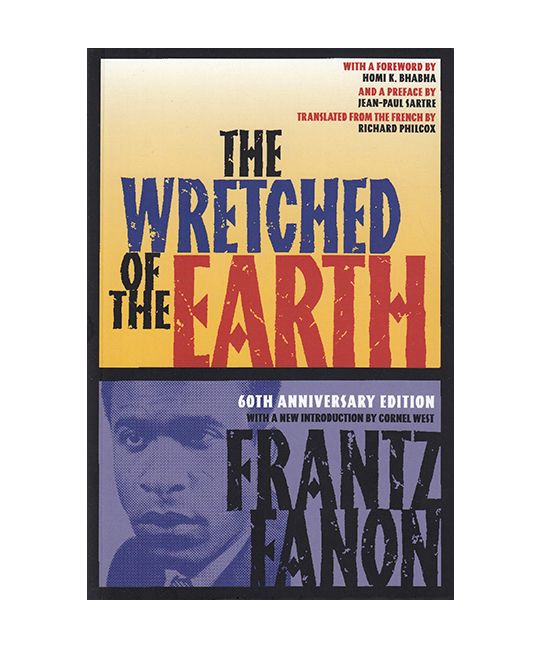

Ideas were percolating in my mind. This previous campaign of mine, when I said “vaguely Iberian” it was also Frankish. And while Frankish is not the same as French (it’s the precursor, technically), I began to imagine what was on the side side of the ocean, in this analogue to the Mediterranean? What cities were on the other side, that may have been previous “conquests”?
I got a book of Algerian history from the library and fell in love a little bit with the city, conceiving of an imaginary space where in the past their resources had been extracted by these fantasy Franco-Iberians, but they’ve since thrown off outside control and are now a proud beacon of independence. A republic, even! I always try to tie one campaign to the other, and in this case it was this old kingdom so haunted by ghosts and werewolves they’d forgotten their colonization of far off places.
Elias Canetti’s quote at the beginning strikes a chord with me because humans have always imagined themselves in larger groups. Long before the first cities, prehistoric peoples imagined for the first time what it would be like to see crowds, to be surrounded by strangers all living in concert and close proximity and to experience that with the senses: the smell of humans, the crash of all that noise...
Let’s do what those people did, and imagine a city. The city of all cities, a fantastical metropolis with magic added to the mix.
This fantasy world-building issue of Hearthside will cover my methodology for naming fictional things, using the body as a metaphor for writing prompts to flesh out a city, when to use complex and simple maps (and how they can help, rather than hinder), as well as the issue of scale when it comes to keeping track of locations.
What’s In a Name
When I come up with names, I like to learn how places and things got their names in the real world. I’m imagining a fantastical analogue to the Southern coast of the Mediterranean, and there are lots of cities to learn about!
Algiers from the French Alger, from Arabic al-Jaza’ir meaning “The Islands”. This refers to four islands that lay off the coast until they were incorporated into the city proper in 1525. Fun fact: the Greeks called the place Ikosion, believing it was built by the 20 companions of Hercules on his Trials!
Tunis comes directly from Arabic. Its origin either comes from a Phoenitian Goddess “Tanith” (as many ancient cities had patron Gods) or the Berber verbal root ens (which means to lie-down, i.e. make camp). This Berber root is likely in reference to Tunis as a kind of last stop before travelers reached Carthage.
Tripoli is a Greek name meaning “Three Cities”. Tripoli-of-the-West was founded by Phoenicians in the 7th century, where they called the place Oyat. It later passed on to Greek rulers. Tripoli in Arabic is affectionately called Arusat al-Bahr, or literally “Bride of the Sea”.
Cairo comes from Arabic al-Qahirah, meaning “Vanquisher/Conqueror”. In the 8th century at its founding, the legend goes that the star Mars was ascendant overhead, so the new settlement was named in honor of Mars to give future conquests some good luck. Alternatively, old Coptic names for the area are Kairon or Kahira.
I love learning how places acquired their names. Often they hint at old quirks of geography that have since changed, or hint at ancient origins that have been built-over as new groups of peoples arrived and took over (in this case first the Greeks, then Arabs).
Of all of these, my personal attachment is to Algiers and its “The Islands”. I like the idea of my fantasy metropolis being old and repeatedly built upon, such that they would’ve had several islands incorporated into the city-proper. Looking at the Arabic names of numbers and messing around, I eventually landed on this pairing:
Three Islands → Thalatha Aljuzur → Thal Juzur → Talzur
Mixing and matching these words together - to try and see how these words would’ve changed over time being spoken repeatedly - I landed on naming my metropolis Talzur. From my reading of Tripoli’s moniker, I really like the idea of Talzur being called Agrud al-Ilel, borrowing Berber words for “Daughter of the Sea”. Instead of being a bride, it’s represented as an eldest daughter, the union of land and sea. This lead me to think that the city’s patron deity would be the daughter of two established D&D deities: Kord and Melora, the Stormlord and the Wildmother.
This kind of creative ideation works for me because while I’ve done quite a bit of linguistic research for only one name, now I have all this methodology to use for other names when I need them. This fantastical analogue to North Africa - my Tazibba Coast, named after the Berber word for “Maze” - will have plenty of neighbors across its far span. It’s not necessarily the “right” way to name things, as it’s certainly an involved process. It’s what gets me to feel good about fantastical names, to make fantastical places feel real in my mind. And that’s why I like it.
I encourage you to play around with names, in whatever way that they feel real to you. That’s what really matters. For this city and its surrounding area, I love including Arabic as well as Berber dialects: Tuareg, Amazigh and more, and this is my process.
The Body of a City
Borrowing methodology (again) from my GM hero Jim Davis of WebDM, think of the city as a living organism full of body parts with different purposes. These prompts really helped me flesh out what this place is like, as well as how average people exist within it. After all, it’s not just an adventure site but an ecosystem of people!
Brains: Who’s in charge of this place?
Heart: Who keeps this place alive?
Stomach: What do they eat? Is it produced inside or outside the city?
Muscles: Who does the labor?
Immune System: Who protects things? Who keeps things from changing?
Nervous System: How do they communicate? How does news spread?
Bones: What’s the history? Why this place?
Blood: How do things circulate? How do people move around, what’s the infrastructure?
Digestion: Where’s the waste go?
Reproductive: What’s the role of sex and love? Prostitution?
Gut Flora: How do outsiders/outcasts/criminals interact within the city?
Here’s some examples as applied to Talzur…
Brains → Talzur became a Republic after its independence from that Iberian/Frankish kingdom I mentioned earlier. The city’s people are the mandate of power, and citizens elect local councilors. The parties are vast, varied and complex, but are representative more of the places (and the things the people who live there believe and need) than overall ideologies. These parties elect seven senators, who in turn nominate figureheads for direct election. Technically a President governs Talzur, but after decades of confusion from the outside world (many of which are still in a Medieval level of technology) they call them The Sovereign.
Why? An aside: TTRPGs are art. They fall in with other artistic mediums (books, movies, music, etc) as being inherently political. I really like the idea of taking a fantasy metropolis - whose tropes include decadence, political corruption and the nastiness of too many people crowded together - and turning that on its head with a government that generally serves its citizens. Not even just “a place I’d like to live” but something really different. Imagining different social systems and ways of living are ideal ways of forging ahead real futures (magic aside). This is much more common in science-fiction, but a broader umbrella of “Imaginary Fiction” can certainly include fantasy (see The Fifth Season, The Master of Djinn, etc).
When I look to the MENA region in real life, I see people yearning for freedom. After years of analysis on The Arab Spring many Western writers still think that these countries “are not ready for democracy”. In my writing, I firmly want to reject that idea through creation: the opposite is true, that the world was not ready for genuine Arab cries for democracy and freedom. This is something I feel very strongly about, even as we live in times of global rises in authoritarianism and fascism. One of my greatest inspirations is P. Djelli Clark’s The Master of Djinn, which shows an imaginary Cairo after magic paves the way to end outside control, where magic changes the fulcrum of power worldwide. I find that so, so interesting and want to engage with those ideas in my own art. I make no claims to cure-all with my words, but art is inherently political and these are the politics I’m baking into my fantasy world.
There’s also a conversation to be had about how I’d feel about the usage of Islamic history as inspiration (or the usage of Arabic and Berber language) if this was a product I was going to sell…but this is not a product, and that’s a conversation for another day.
So, Arabic speaking Islamic-inspired democracy. In a metropolis. Not that hard to suspend my disbelief when we have wizards and dragons…
Muscles → Talzur has a large labor force of minotaurs. I imagine them as the original population of the area around Talzur, their mazes being the first layer that the city is built upon. Besides minotaurs, a lot of laborers are Dwarves and Goblins.
I want to re-contextualize the feud between them as a class struggle instead of something racially motivated. A dwarf-lord got a contract signed with the city for construction permits, and the contract is good up to the natural life of his grandson. “We have precedence until my son’s son dies of natural causes”. That was hundreds of years ago, but that dwarf-lord’s son hasn’t even kicked the bucket.
This is such a long period of time that the city’s government has changed, and this company of dwarves frequently come into conflict with the Goblin Unions. The Goblin Unions don’t have the pedigree of their dwarf competitors, but they can organize like hell into contracts that…sometimes…arbitrate against the dwarf’s permits, or get them to back down from a fight. Tensions grow every year this goes on.
Bones → Layers upon layers!
Minotaur Civilization, Mazes everywhere
Alexander-style conqueror, but if he was an Egyptian Pharaoh
Imperial Dark Age (two separate empires ruled, records are nill)
Genasi Sultanate
Holy Kingdom occupation, overthrown in Revolution
Republic Independence (current: 150 years old!)
Digestion → Massive sewer system! Further reinforce this idea that there’s all this stuff down there, and something needs to sweep it all away. A lot of those minotaur mazes were likely retrofitted into the first sewers, and it’s eaten by the classic D&D monsters: Gelatinous Cubes, Otyughs and other spawn. The rest sinks down into watersheds all the way down to the Underdark, where terrible things mingle and bubble up to the level of spelunking adventurers.
This is the tonal change I’m living for, sewers full of monsters is why I want to run a fantasy metropolis. Another common trope are Rat people (or were-rats…). I think there’s so much trash and waste that it animates spontaneously into these Rat Men, mimicries of the life on the surface they can never touch. Additionally, that way players carving through hordes of rat men don’t need to feel like they’re cutting off a whole clan full of hopes and dreams. They’re zombies, not people. They’re made of trash!
The Map is Not The Territory
Maps are less important than the content or text of a setting, everything needs to be fleshed out and interconnected first before it can be portrayed visually. But, how else are you going to keep track of all these fictional places if you can’t keep records?
In all my research I stumbled upon a really cool map. Check this out:
This is a map of Algiers done by an infamous Ottoman cartographer named Piri Reis. Besides the lovely use of color and the lines guiding your eyes across the page, the most striking feature is its orientation. Rather than show the coast as a roughly horizontal line following the traditional West to East, the coast is drawn top to bottom of the page. While maintaining the real cardinal directions on those ornate compasses, the world is rotated to show the importance of this city built on incorporated islands. North Africa’s coast is the guiding axis of the world here, and the rest of the world is rotated to give us her best view.
I love this map so much. This was one of the first maps I’d ever seen that broke away from traditional Eurocentrism, broke away from Europe up top and everywhere-else left underneath. And it’s a real, historical map!
Using Hexographer and Photoshop I made this Reis-inspired map of the Tazibba Coast for Talzur to sit on:
Now, I actually don’t encourage you to make this all out of the gate. I tend to follow my muse when theory-crafting, and making a whole region around a city (the place I intended to actually run my game…) was definitely a muse situation.
Let’s compare this ornate and elaborate region map to what I eventually settled on as a city map:
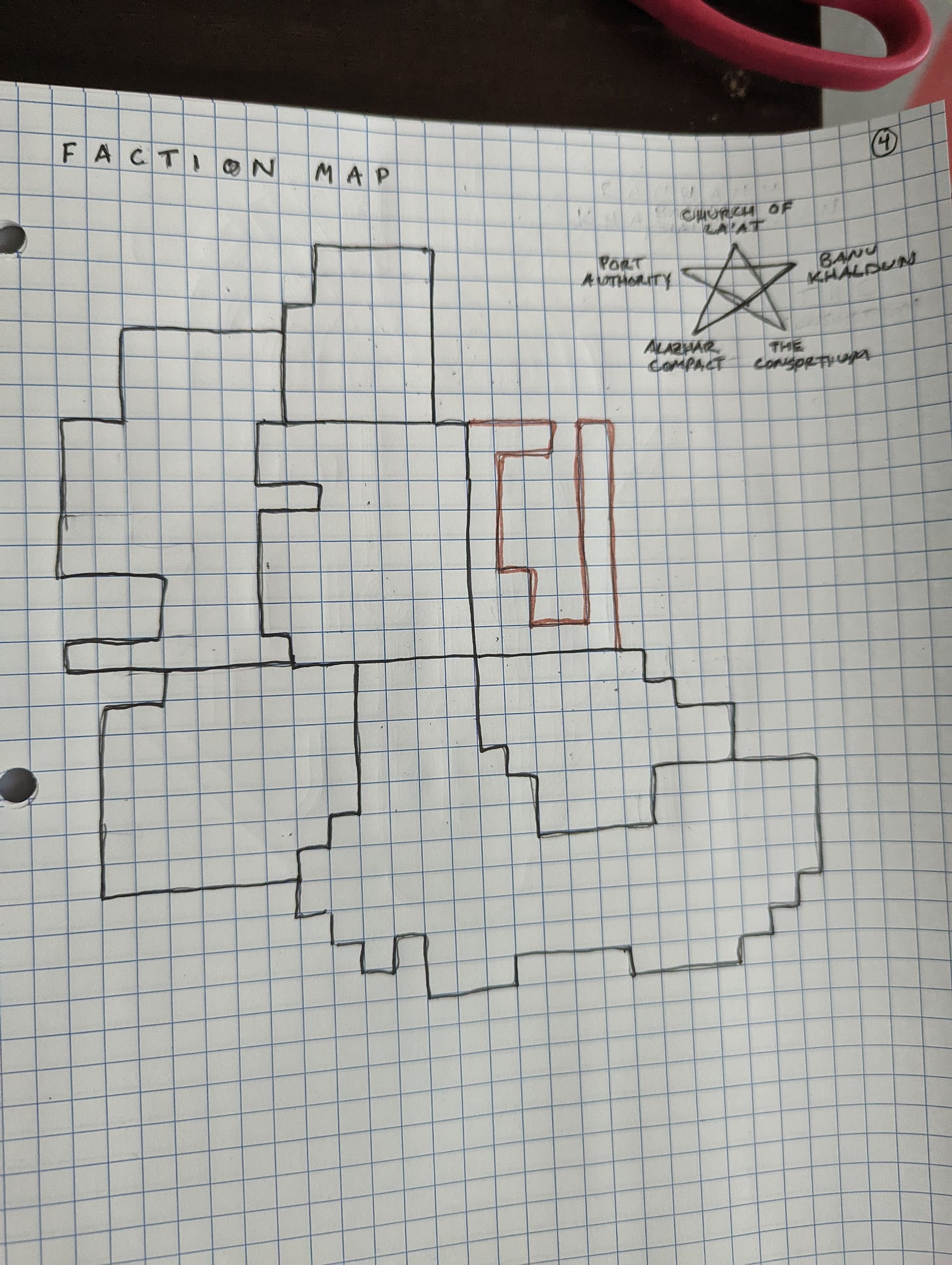
Oh, yeah. Now this is a map I can actually use. Evocative, but it gets the idea across and is largely empty for future notes. Here are the seven districts of Talzur. The sea would be in the upper right corner, past that brown U that’s supposed to be The Docks. There’s a time and place to make ornate maps (for players, usually) but in your own notes, my advice is to keep them bare-bones and focus on keeping good records. Your maps should assist you in taking notes, not hinder you.
On this specific map I’ve made space to record the headquarters of the five big factions, so that I know where the centers of power are and in-relation to each other. This helps me keep a handle on things when I want to write-out how the factions are nipping at each other, or look for quest hooks to further entice my players to do fun stuff (or help them get to the do the fun stuff THEY want to do!).
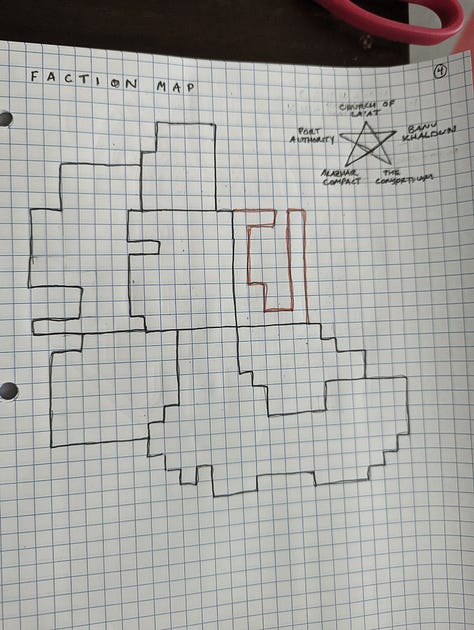

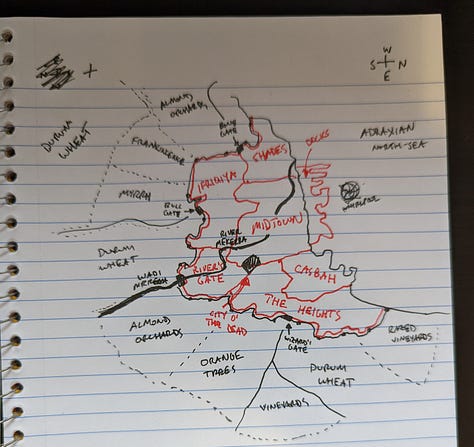
For full transparency, these are the rough drafts of my hand drawn city maps. The one on the right was dense with detail: figuring out where the river would cut through, what fields exist right outside the city walls and thinking about agriculture. Then I simplified, keeping the basic shapes and enlarging them. From there I drew the simplest version of the city map for my notes. I find it’s way easier to overdo and pair down (draft a bunch and then kill your darlings) than to summon details from nothing when I need them.
Scale or be Scaled
Once a map exists and you start making locations, you need to think about scale. It’s impossible to keep a street by street accounting of all this content (unless you’re doing #city23 instead of #dungeon23), so keeping categories of where things are located is very useful. Once it’s spoken aloud at the table it’s canon! Ptolus is an infamous example of a huge top-down content of street by street information in a massive tome. While I find inspiration pouring over that brick of a book, I do think Ptolus is too complex. I am imagining Talzur in loosey-goosey “range-bands” of scale.
Range Bands
At it’s largest point, this is a city. One level down, a city is made up of districts. Call them districts, wards, zones, whatever. Within a district are many neighborhoods, that can either be cultural hot-spots, enclaves of a specific ancestry or be built around landmarks. Within neighborhoods are locations: places where players can move square by square on a battle map, or set up shop and run a tavern with rats in the basement. To put it another way:
City → District → Neighborhood → Location(s)
Within the city of Talzur, there are 7 districts. One district - Midtown, for example - might have 4 different neighborhoods and 16 local areas spread across each. You might use a generator and say there’s a potion shop in the the neighborhood Lebanville, but you shouldn’t have to worry about reckoning the location’s position in comparison to other locations unless the players need to know. These layers of abstraction can help you keep tabs on where things are, without having exact coordinates in mind. Abstract ranges and groupings serve me well enough.
“Oh, you rolled a history check? That landmark is in Lebanville.” You make a note for later and move on, unless the player asks “Where exactly in Lebanville, so I can tag it with magic paint for my guild?” At this point you need to decide (arbitrarily really) where it is within the neighborhood, make a note, move on.
“You look through the library and find the pillar you need is in Serkeftin Hill, up the street from a coffee house frequented by gnomes.” The players learn of this neighborhood (Serkeftin Hill) for the first time, but don’t need to roll to know that it’s located with a district called Ifriqiya because they’ve already been there on the western side of the city. When they travel to said pillar and have to fight some ruffians around it, the location is represented by the street and back alleys around that pillar. Yet, one neighborhood can be a big place and lots of locations can be there: amphitheaters, meat markets, factions centers…
I hope these examples get across the kind of abstraction I go for. Keep locations in mind for your notes and so you don’t get crisscrossed, but don’t feel the need to world-build your city lane by lane. I don’t!
In Conclusion
I’ve had the luxury of whittling away at this metropolis over the course of almost a year, while we were wrapping up a long 3 year campaign and then took a season off for a break. Any artistic project is only possible by breaking down a big task into 1,000 smaller tasks…and then doing them! It’s how I work on my fiction writing, my D&D prep and my game design: plot out tasks and do them when you have spare time, or make a lot of progress in one area when the mood strikes you. The key is incremental progress, creating and combining ideas until the place becomes real to you. When it’s real to you, it’ll be even more-so in the eyes of your players.
As I write this I’ve already run a few sessions in Talzur, and they’ve been a huge blast. Part of its success is that this is a tight-nit group of players, but also that I’ve done enough prep work that I feel confidant straying from the path in a way that I know won’t hinder me later on. My methodology or process is just one way to do things, and I hope I’ve gotten that across to the point where you feel empowered to figure out your own process. Or, hey, steal mine! It’s fair game.
In the future I’ll be doing more articles in this vein as I keep running, but will focus on methodology, lessons and advice rather than action-reports! Tales from the Dripping Tap will center on running a complex urban campaigns, featuring an in-universe bartender and sharing more of the factions from last week’s faction star. Cities always begin in the mind, you just have to start piece by piece.
As always - Keep writing!



